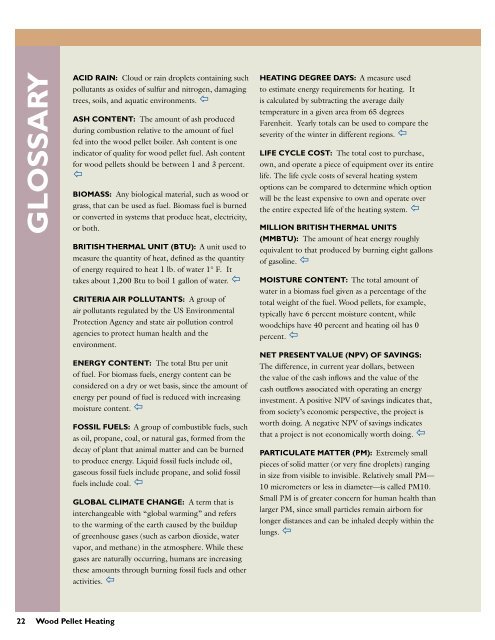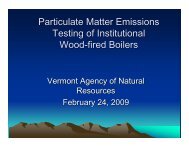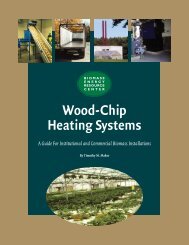Wood Pellet Heating - Biomass Energy Resource Center
Wood Pellet Heating - Biomass Energy Resource Center
Wood Pellet Heating - Biomass Energy Resource Center
You also want an ePaper? Increase the reach of your titles
YUMPU automatically turns print PDFs into web optimized ePapers that Google loves.
glossary<br />
Acid rain: Cloud or rain droplets containing such<br />
pollutants as oxides of sulfur and nitrogen, damaging<br />
trees, soils, and aquatic environments. <br />
Ash content: The amount of ash produced<br />
during combustion relative to the amount of fuel<br />
fed into the wood pellet boiler. Ash content is one<br />
indicator of quality for wood pellet fuel. Ash content<br />
for wood pellets should be between 1 and 3 percent.<br />
<br />
<strong>Biomass</strong>: Any biological material, such as wood or<br />
grass, that can be used as fuel. <strong>Biomass</strong> fuel is burned<br />
or converted in systems that produce heat, electricity,<br />
or both.<br />
British thermal unit (Btu): A unit used to<br />
measure the quantity of heat, defined as the quantity<br />
of energy required to heat 1 lb. of water 1° F. It<br />
takes about 1,200 Btu to boil 1 gallon of water. <br />
Criteria air pollutants: A group of<br />
air pollutants regulated by the US Environmental<br />
Protection Agency and state air pollution control<br />
agencies to protect human health and the<br />
environment.<br />
<strong>Energy</strong> content: The total Btu per unit<br />
of fuel. For biomass fuels, energy content can be<br />
considered on a dry or wet basis, since the amount of<br />
energy per pound of fuel is reduced with increasing<br />
moisture content. <br />
Fossil fuels: A group of combustible fuels, such<br />
as oil, propane, coal, or natural gas, formed from the<br />
decay of plant that animal matter and can be burned<br />
to produce energy. Liquid fossil fuels include oil,<br />
gaseous fossil fuels include propane, and solid fossil<br />
fuels include coal. <br />
Global climate change: A term that is<br />
interchangeable with “global warming” and refers<br />
to the warming of the earth caused by the buildup<br />
of greenhouse gases (such as carbon dioxide, water<br />
vapor, and methane) in the atmosphere. While these<br />
gases are naturally occurring, humans are increasing<br />
these amounts through burning fossil fuels and other<br />
activities. <br />
heating DEGREE DAYS: A measure used<br />
to estimate energy requirements for heating. It<br />
is calculated by subtracting the average daily<br />
temperature in a given area from 65 degrees<br />
Farenheit. Yearly totals can be used to compare the<br />
severity of the winter in different regions. <br />
Life cycle cost: The total cost to purchase,<br />
own, and operate a piece of equipment over its entire<br />
life. The life cycle costs of several heating system<br />
options can be compared to determine which option<br />
will be the least expensive to own and operate over<br />
the entire expected life of the heating system. <br />
million British thermal units<br />
(MMBtu): The amount of heat energy roughly<br />
equivalent to that produced by burning eight gallons<br />
of gasoline. <br />
Moisture content: The total amount of<br />
water in a biomass fuel given as a percentage of the<br />
total weight of the fuel. <strong>Wood</strong> pellets, for example,<br />
typically have 6 percent moisture content, while<br />
woodchips have 40 percent and heating oil has 0<br />
percent. <br />
Net Present Value (NPV) of Savings:<br />
The difference, in current year dollars, between<br />
the value of the cash inflows and the value of the<br />
cash outflows associated with operating an energy<br />
investment. A positive NPV of savings indicates that,<br />
from society’s economic perspective, the project is<br />
worth doing. A negative NPV of savings indicates<br />
that a project is not economically worth doing. <br />
Particulate matter (PM): Extremely small<br />
pieces of solid matter (or very fine droplets) ranging<br />
in size from visible to invisible. Relatively small PM—<br />
10 micrometers or less in diameter—is called PM10.<br />
Small PM is of greater concern for human health than<br />
larger PM, since small particles remain airborn for<br />
longer distances and can be inhaled deeply within the<br />
lungs. <br />
22 <strong>Wood</strong> <strong>Pellet</strong> <strong>Heating</strong>





